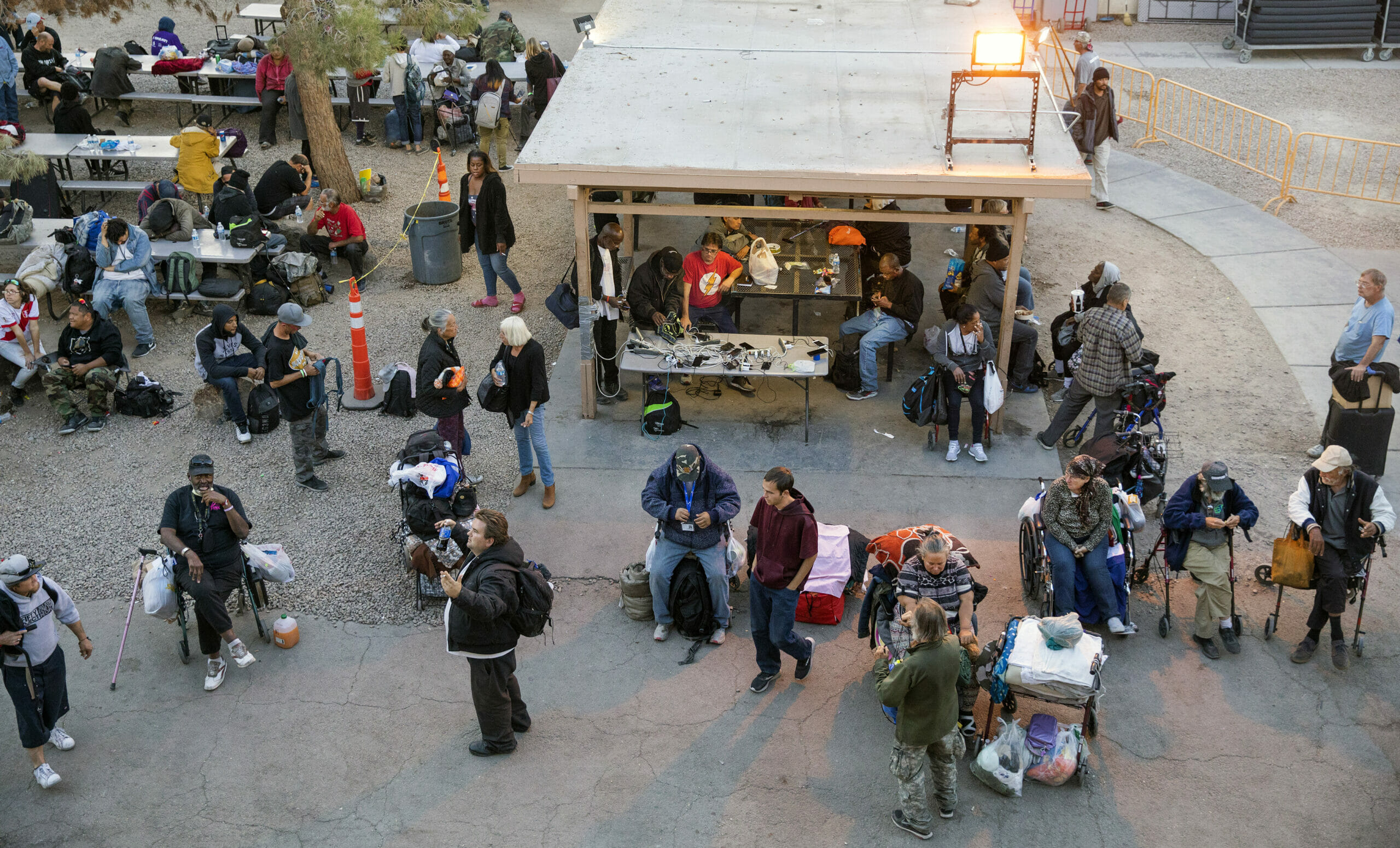Mapping shelter in the storm

When a defensive Las Vegas Mayor Pro Tem (and person most likely to shoot the Grinch for trespassing before his heart is given a chance to grow) Michele Fiore says “I would really like for you to show me when the city of Las Vegas has ever jailed a homeless person.” I think I know where she’s going. To her sweet, semantic credit, there is no explicit crime of “being homeless” on the books; also the City of Las Vegas Jail apparently doesn’t keep solid statistics on who is currently (or on the verge of being) homeless – and with no data to contradict, she can lock and load her assertions. Then, she and a majority of her strangely silent fellow council members can with a clear conscience, advocate for more and more ordinances making it unlawful to “exist” on a public sidewalk for any extended period of time – a crime that no person with a real home to live in will ever be charged with.
Likewise, the actual mayor of Las Vegas calls for additional criminalization as a necessary measure to give the city’s all-in, possible boondoggle called “the Courtyard” a boost in relevance (and numbers of people served) through coercion. The mayor’s oft repeated justification (which she earnestly believes) for every recent (and mostly protested) action of the City goes something like this: The City of Las Vegas had to do something to stem the negative consequences of what appears to be surging homelessness and placate angry business owners, residents and potential developers who see homelessness as blight detrimental to profit, safe living and future growth; and if people who are homeless won’t take advantage of available services, then they need to be super-pressured into seeking help.
The mayor sees this as a win-win; she placates the non-homeless people calling for action; and she gets to engage in “tough-love” which the mayor assumes will result in people who are homeless being better off – especially since she believes the Courtyard is “a great first step,” albeit one that seems to be a step along a journey paved mostly with good intentions on a way to gross inefficiency.
In fact, on the tough side of "tough love," there has been no effort to track how many are arrested under the new ordinances or even what specifically happens with individuals arrested for crimes mostly associated with homelessness (a number - I’d guess based on my personal observations - which represents a much higher population of the jail than is being estimated). And on the love side...there doesn't seem to be much interest in deep diving into impact outside superficial numbers of people seen and, generally, if those same people get a decent referral to services. In other words, no comprehensive, mandatory data sets tied to the Courtyard plan to really measure and evaluate its existence.
By now, it may be obvious that I’m not the biggest fan of the Courtyard concept, and I have many reasons. I don’t buy into the “something”-is-better-than-nothing driver for spending tons of money on a concept without there being a practical model with measurable deliverables; or a positive impact model which also takes into account cost-efficiency (compared to how much other things cost) and the unintended consequences of implementation. That is to say, I’m not impressed with how they decided that this expensive (and getting more expensive) thing was the best use of money and resources and how good is it to get people into permanent housing versus whatever was happening before it was built. I get that a coalition of Las Vegans went to San Antonio and saw a similar-ish, privately-funded concept that blew them away, but alas, it too, is not without its critics or concerns and it has 10 times more funding, significantly more space and exists in a city with less than half the population of homeless than we have.
However, the thing I like least about the Courtyard is that the City of Las Vegas went at it alone – without the sort of vetting that results-tied funding and/or collaboration with their regional partners through the Continuum of Care would necessarily provide. Mayor Goodman has famously repeated that she was tired of “meetings and binders” and was ready to act – and yet, having been to many of those meetings and seen many of those binders, I was most impressed with how much data is available and under-utilized in effective problem solving.
I’m referring to the Continuum of Care, which is charged with shepherding and developing the best policies, and through the county, is also the applicant for HUD funding and the gatekeeper for data and coordinator of providers and connector to HUD and other federal programs (yeah, it’s charged with a lot and doesn’t get nearly enough resources to do all these things).
Here in Southern Nevada (as is true in many communities around the country) we utilize something called a Homeless Management and Information System (“HMIS”), known as “Clarity Human Services.” It’s basically required to ensure compliance with federal funding guidelines. “Clarity” is created by Bitfocus, a Nevada company that has expanded its operations to many cities. Recently, the data collection has not only been used for compliance but also to prioritize distribution of the resources that are available. In fact, the system is so advanced that it is flexible enough to continually add new data points, and generate reports that could predict and presumably prevent greater homelessness in the future. However, we’re not doing that quite yet – at least not in any expansive or comprehensive way.
Southern Nevada has recently added data points when the need arises; for instance, adding in the name of a person’s Medicaid/insurance when available and that actually helps providers. However, there are literally tens of thousands of data points that can yet be added. That’s how the HMIS works – it not only creates a sort of file on the individual to assist providers in streamlining and tracking services, but collectively the data can also be anonymized and we can see snapshots of all the people using the system and theoretically draw conclusions upon which we can act.
Set this against the current disconnect of municipalities like Las Vegas creating policy, isolated from real data and analysis, and misusing (or not contextualizing) the available data for good policy decisions. I understand data and stats don’t build houses, but it does give us a guidepost of where to head and to determine if what we’re doing is working. It complements the human voice. The feelings and foibles of living people. The stories and gut reactions. They all have a place in the dialogue of what we should be doing and who we are, along with the data telling the tale. But data gathering can’t be selective (let alone ignored) and it must be contextualized or it fails to adequately inform. We also need comprehensive audits on the regular. So when it comes to the Courtyard, there is data that gets talked about, but it is so grossly incomplete that it should be a crime to use it to justify the City’s decision-making. Whatever numbers are pulled (likely from “HMIS”), there is so much more to the story; so much comparative analysis that must be done.
For instance, while the City points to “serving” more than 6,200 individuals in the first year of the Courtyard’s operation, what about (the complete data of) how many of those people were already in the system; how many were already getting services from the third-party providers they encountered at the Courtyard; and how many are getting into permanent, sustainable housing which is the ultimate goal? Also, a cost analysis of return on investment (including more transparency and metrics concerning the multi-year, hundreds of thousands of dollars contract to have an outside staffing agency called Marathon Staffing do the on-site social work).
And that’s all before we even look at the numbers of how many people’s situations have worsened after hitting the Courtyard (or being forced to go there; or coming out of jail) or the effectiveness of staffing issues or even security (now, very much in the hands of yet another third-party provider named Allied Universal) at this facility.
There’s a lot of data to consider, and that’s just not being done by those who are jumping into the fray with both feet. In speaking with Bitfocus, it seems like big things could be on the horizon if Southern Nevada wants to take advantage of the tech. And while it's not perfect (heavily reliant on self-reporting, privacy concerns, gaps from insufficiently trained providers, etc.), it is preferable to the sort of guessing that seems endemic amongst the decision-makers. I mean, did you know that to even determine how many people are currently homeless, we use a baseline number that comes from a large group of volunteers equipped with flashlights peeking around corners on a random night and keeping a tally? Seriously. This is how we got the oft-utilized 2019 number of “more than 5200 on any given night.” I’d imagine digging deeper into the data and comparing notes would be a useful endeavor but ya know…those pesky meetings and binders.
While programs and providers (even those that flow through the Courtyard) are vital, there needs to be a significantly greater, concerted effort to figure out what data we need and what we can do with it in order to create better, sustainable effective models. The Clarity system is an indispensable tool that can likely do so much more than it is in providing so much more information to shed light on the situation. Heck, once all people challenged by homelessness are in an improved data base, we might be able to start incorporating other programs and technology for the benefit of everyone. As is, we are literally screwing with people’s lives on hunches and prayers – and even the most dissatisfied business owner is not going to be happy in the long-term with the lack of quantifiable results. There’s no reason to not know what percentage of people sentenced to time in our local jails are currently or on the verge of homelessness; there’s no reason to not have a more accurate count of people who are homeless or data on where we can spend money most effectively.
Accurate, complete data might not get us through the storm, but unlike the current rhetoric, it can more definitively tell us if we’re walking toward sanctuary or taking a first step into the sea.
Dayvid Figler is a criminal defense attorney based in Las Vegas. He previously served as an associate attorney representing indigent defendants charged with murder for the Clark County Special Public Defender’s office. During his legal tenure, he served a brief appointment as a Las Vegas Municipal Court judge. Figler has been cited as a noted legal expert in many places including the New York Times, National Public Radio, Newsweek, USA Today, Court TV and the Los Angeles Times. His award-winning radio essays have appeared on KNPR as well as on NPR’s All Things Considered program.
